The Brazos Performance Preview: AMD E-350 Benchmarked
by Anand Lal Shimpi on November 16, 2010 12:01 AM ESTMemory and Cache Latencies
The Brazos platform was configured with 4GB of DDR3-1066 memory. The IDF system had memory running at DDR3-1333, however AMD had to decrease clocks presumably to meet validation requirements for final silicon. I measured an 86.9ns trip to main memory, a 3 cycle L1 and a ~22 cycle L2 cache. That's a lower latency memory interface than Atom or Core 2 based processors, but a higher latency L2.
CPU Performance: Better than Atom, 90% of K8 but Slower than Pentium DC
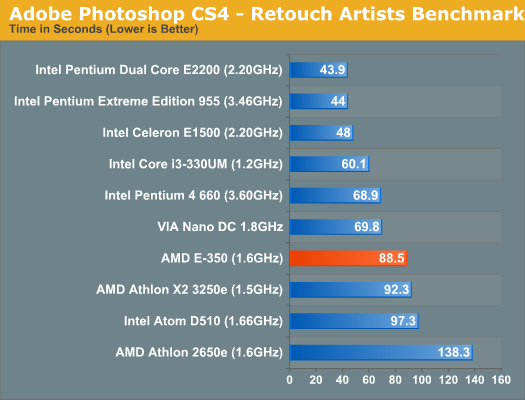
AMD's performance target for Bobcat was 90% of the performance of K8 at the same clock speed and our Photoshop CS4 benchmark shows that AMD can definitely say that it has met that goal. At 1.6GHz the E-350 manages to outperform a pair of K8s running at 1.5GHz in the Athlon X2 3250e. Unfortunately for AMD, Intel's Pentium dual-core running at 2.2GHz is much quicker. Most notebooks in the $400+ range have at least a 2.2GHz Pentium. Even the Atom D510 isn't far behind.
AMD tells me that in general purpose integer tasks, the E-350 should do well and it may even exceed AMD's 90% design target. However in higher IPC workloads, for example many floating point workloads, the E-350 is constrained by its dual issue front end. In these situations, the out of order engine is starved for instructions and much of Bobcat's advantage goes away.

Our x264 HD test has the E-350 performing within 86 - 92% of the Athlon X2 3250e, once again meeting AMD's design targets. Unfortunately, this isn't much faster than an Atom - mostly thanks to Atom's Hyper Threading support. Although not an out of order architecture, Atom gets a healthy efficiency boost by being able to execute instructions from two threads per core. Once again, compared to a 2.2GHz Pentium, the E-350 isn't close. Even VIA's dual core Nano is faster. When it comes to power consumption however, the E-350 can't be touched. I measured max system power consumption at 25.2W while running the x264 encode test. With the exception of the Atom D510, the rest of the desktop platforms here consume much more than that at idle (much less under load).
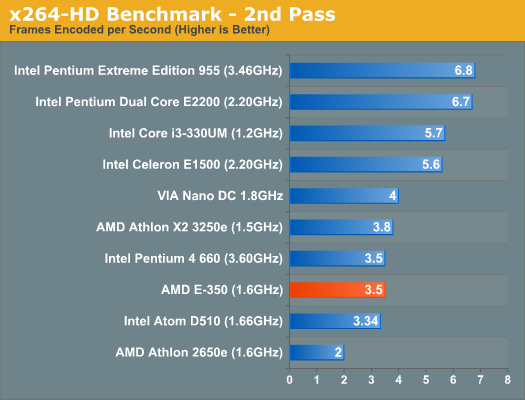
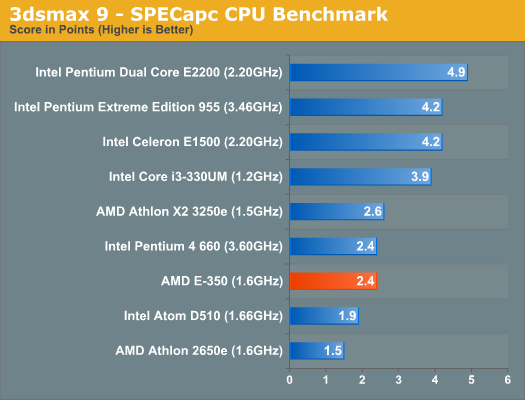
Despite being a offline 3D rendering benchmark, our 3dsmax 9 test does fall in line with expectations. The E-350 delivers 92% of the performance of the Athlon X2 3250e and outperforms the Atom D510 by 26%. Unfortunately for AMD, the Pentium dual-core holds onto a significant performance advantage here. Clock for clock, Bobcat won't be able to do much against anything Core 2 based. The real advantage here will be GPU performance.
Single Threaded Performance
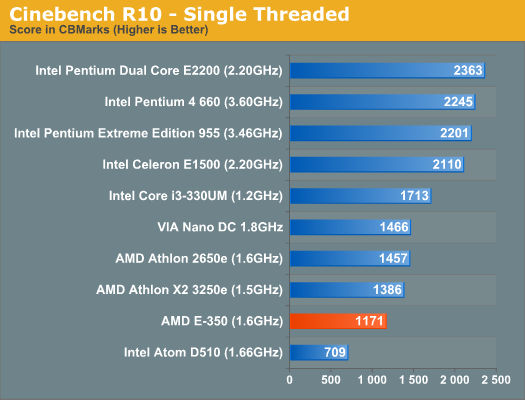
In most of our benchmarks the performance advantage over Atom isn't huge, yet using Brazos is much better than using an Atom based machine. It all boils down to one thing: single threaded performance. Atom can make up for its deficiencies by executing a lot of threads in parallel, but when you're bound by the performance of a single thread the E-350 shines. The E-350 is 65% faster than the Atom D510 in the single threaded Cinebench R10 test. It's this performance advantage that makes the E-350 feel so much quicker than Atom.
The Core i3-330UM manages a 46% performance advantage over the E-350. Even in the ultraportable Arrandale ULV space at lower clocks, AMD still leaves a lot of CPU performance on the table. The advantage here will be cost. A single E-350 is less than 40% of the die area of a Core i3-330UM. You may not get the same CPU performance, but performance per mm^2 is much higher.

In the multithreaded Cinebench test Atom is able to catch up quite a bit, but the E-350 still holds an 11% advantage.
File Compression/Archive Recovery Performance
Our final two CPU tests are both multithreaded and they show the E-350 equaling and falling behind the performance of the 1.5GHz Athlon X2. As we explained earlier, the gap between the E-350 and Atom shrinks as you add more threads to the workload.
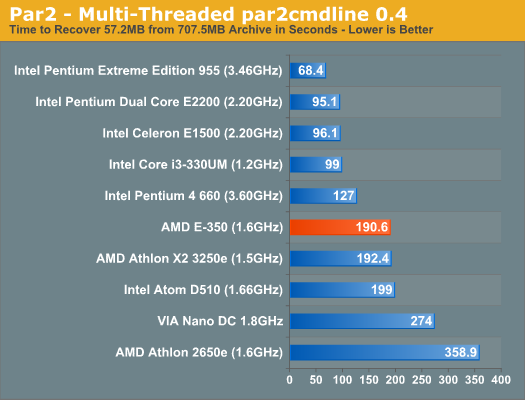
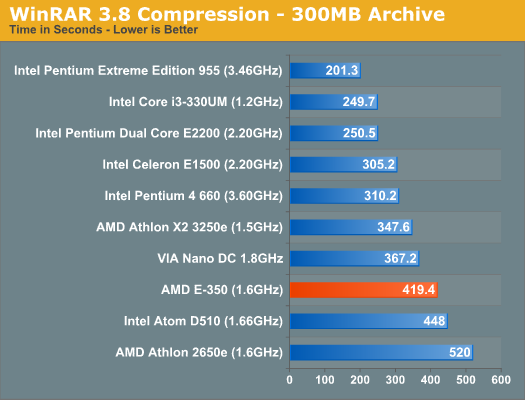










207 Comments
View All Comments
flyck - Wednesday, November 17, 2010 - link
i withhold my comment on that until we see the ontario product competing with a single core atom... which will be a 9W single core 1.2Ghz and not zacate.ltcommanderdata - Tuesday, November 16, 2010 - link
So based on these results, despite a bit of excitement of AMD showing Apple computers on their recent press slides, it doesn't seem like Fusion is Apple's ideal CPU/GPU solution. Brazos has neither the CPU or GPU power to replace the current CULV Core 2 Duo + 320M solution in the 11.6" MacBook Air. For 13.3" MacBook, MacBook Air, and MacBook Pro, Llano looks to have the GPU power, but not the CPU power to go against Sandy Bridge, but the bigger problem is timing since it looks like volume shipments won't be until H2 2011 which will be close to Ivy Bridge. As such, Apple's best solution for their 11.6" and 13.3" models seems to be to stick with Intel processors for best CPU performance and figure out how to fit a discrete GPU, which could be an AMD one if they can get an acceptable hybrid switching implementation.For the rest of Apple's lineup, they'd probably stick with Sandy Bridge over Bulldozer since Sandy Bridge looks to have the stronger AVX implementation which should be useful for their multimedia and content development applications.
flyck - Tuesday, November 16, 2010 - link
Didn't you look at the power consumption at all?Brazos system consumer 9watt idle, the SU 20W and atom single core 15W
the SU is always 10W higher than Brazos. Only the Atom can be lower with some loads (altough in gaming the atom is not fast enough)
JarredWalton - Tuesday, November 16, 2010 - link
Idle power consumption on CULV 11.6" is down around 9W for the entire platform, and for 10" Atom it's about 6W. Then along comes Apple's MacBook Air and their idle power consumption is apparently in the realm of 5W. Yes, that's FIVE watts for CULV, based on the Air 11 review (http://www.anandtech.com/show/3991/apples-2010-mac... That's a 35Wh battery lasting basically seven hours for light web browsing. Damn!I hope Microsoft can do something with Windows 8 to finally get C-state use to improve. Right now, it's like Windows 7 (which is better than Vista and XP in my testing) still goes around waking up devices and applications. "Hey hey hey! Excel! Yes, I'm talking to you! I haven't seen you request any resources for a while and you look idle, but I'm just making sure. Do you need the CPU? I just woke him up to help out. No? Are you sure? Okay... go back to sleep CPU and Excel. I'll be back in a few milliseconds to see if you've changed your mind! Oh, hey! Word... how ya doin'!? ...."
softdrinkviking - Tuesday, November 16, 2010 - link
Is this level of performance even relevant in the notebook form factor?It doesn't do anything I wont be able to do on the next years smart phones.
Sure, bobcat will do it all faster, but I'll have to lug around a notebook!
haukionkannel - Tuesday, November 16, 2010 - link
Well, actually this is guite good. It seems not eat too much power. It can be used to read web pages like, atom. You can even use word prosessor on it. And when you play, it seems to beat atom.It is not mean to be gaming prosessor. It is very low end mainstream CPUGPU that has reasonable graphic power, and it can delivere just that.
If you want gaming laptop, you have to go to i3 or i5 and from 350 (5650) to 460 (5870). They are in very different league.
I would be nice to see for example a "gaming" tablet made around this product!
beginner99 - Tuesday, November 16, 2010 - link
I really don't get the benefit of this gpu. Does anyone really play starcraft 2 or an FPS on a netbook? No, at least not with these results. IMHO this gpu thing is overrated for netbooks. It should play media files including 1080p (for attaching the netbook to the TV) and also be able to play flash video flawlessly and render flash-heavy web-pages. All of it not really needing a gpu but mainly the video decode engine. Browsing mainly needs (single-threaded) cpu power.And then think it's funny you say the platform felt snappy when it has a crucial ssd and most atom systems ship with a crappy 5400 rpm drive at best. probably 99.9% of the good experience was due to the ssd. I must say pretty smart move from AMDs side.
So an ideal netbook has a semi-decent ssd (even JMicron based ones will be good enough), good single-threaded performance ( I mean video encoding on netbooks is very important,,..NOT) and a video decode engine for the common stuff including software (driver, apps) supporting it.
Calabros - Tuesday, November 16, 2010 - link
Steve should buy this company.. its the only solution :-)ET - Tuesday, November 16, 2010 - link
I do like that different sites use different benchmarks, and it's a good way to get a better overall picture, so even though some other sites have benchmarks that I find more interesting I have no problem with that.Even looking at other reviews, the Brazos looks disappointing from a consumer point of view. It loses in performance to Intel CULV CPU's and isn't much better than available Atoms. It even lost to an Atom D525 + Ion2 in some cases. Extrapolating to the 9W variants suggests that performance will be pretty low.
That said, from an OEM point of view it should be a good replacement for some Intel platforms, because while it doesn't break new ground it should replace the Atom+Ion combination with something smaller and cheaper, and the lower power versions will likely still compete with the Atom while providing better graphics.
Still from my POV I'm pretty disappointed. I had really hoped for something that's game changing.
duploxxx - Tuesday, November 16, 2010 - link
perhaps read that review again...http://hothardware.com/Reviews/AMD-Zacate-E350-Pro...
in some cases it loses and most it wins to a 525 yes which has 2 cores 4 threads and a 1,8ghz, and yes some gpu are better because of the ion2 but it also requires 60% idle power and 30% less load power, say again where it fails? for only being released few months after on first revision...
it makes the competition harder so better for us.